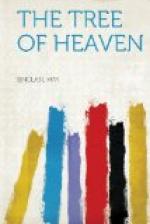“By taking time into account as well as space we produce rhythm.
“I know what you’re going to say, Stephen. The Dancing Faun and the Frieze of the Parthenon express movements. But they do nothing of the sort. They express movements arrested at a certain point. They are supposed to represent nature, but they do not even do that, because arrested motion is a contradiction in terms, and because the point of arrest is an artificial and arbitrary thing.
“Your medium limits you. You have to choose between the intact body which is stationary and the broken and projected bodies which are in movement. That is why we destroy or suppress symmetry in the figure and in design. Because symmetry is perfect balance which is immobility. If I wanted to present perfect rest I should do it by an absolute symmetry.”
“And there’s more in it than that,” said Austen Mitchell. “We’re out against the damnable affectations of naturalism and humanism. If I draw a perfect likeness of a fat, pink woman I’ve got a fat, pink woman and nothing else but a fat pink woman. And a fat, pink woman is a work of Nature, not a work of art. And I’m lying. I’m presenting as a reality what is only an appearance. The better the likeness the bigger the lie. But movement and rhythm are realities, not appearances. When I present rhythm and movement I’ve done something. I’ve made reality appear.”
He went on to unfold a scheme for restoring vigour to the exhausted language by destroying its articulations. These he declared to be purely arbitrary, therefore fatal to the development of a spontaneous and individual style. By breaking up the rigid ties of syntax, you do more than create new forms of prose moving in perfect freedom, you deliver the creative spirit itself from the abominable contact with dead ideas. Association, fixed and eternalized by the structure of the language, is the tyranny that keeps down the live idea.
“We’ve got to restore the innocence of memory, as Gauguin restored the innocence of the eye.”
* * * * *
Michael noticed that the talk was not always sustained at this constructive level. And to-night, towards twelve o’clock, it dropped and broke in a welter of vituperation. It was, first, a frenzied assault on the Old Masters, a storming of immortal strongholds, a tearing and scattering of the wing feathers of archangels; then, from this high adventure it sank to a perfunctory skirmishing among living eminences over forty, judged, by reason of their age, to be too contemptible for an attack in force. It rallied again to a bombing and blasting of minute ineptitudes, the slaughter of “swine like —— and —— and —— and —— and ——“; and ended in a furious pursuit of a volatile young poet, Edward Rivers, who had escaped by sheer levity from the tug of the Vortex, and was setting up a small swirl of his own.
Michael was with the revolutionaries heart and soul; he believed in Morton Ellis and Austen Mitchell and Monier-Owen even more than he believed in Lawrence Stephen, and almost as much as he believed in Jules Reveillaud. They stood for all the realities and all the ideas and all the accomplishments to which he himself was devoted. He had no sort of qualms about the wholesale slaughter of the inefficient.




